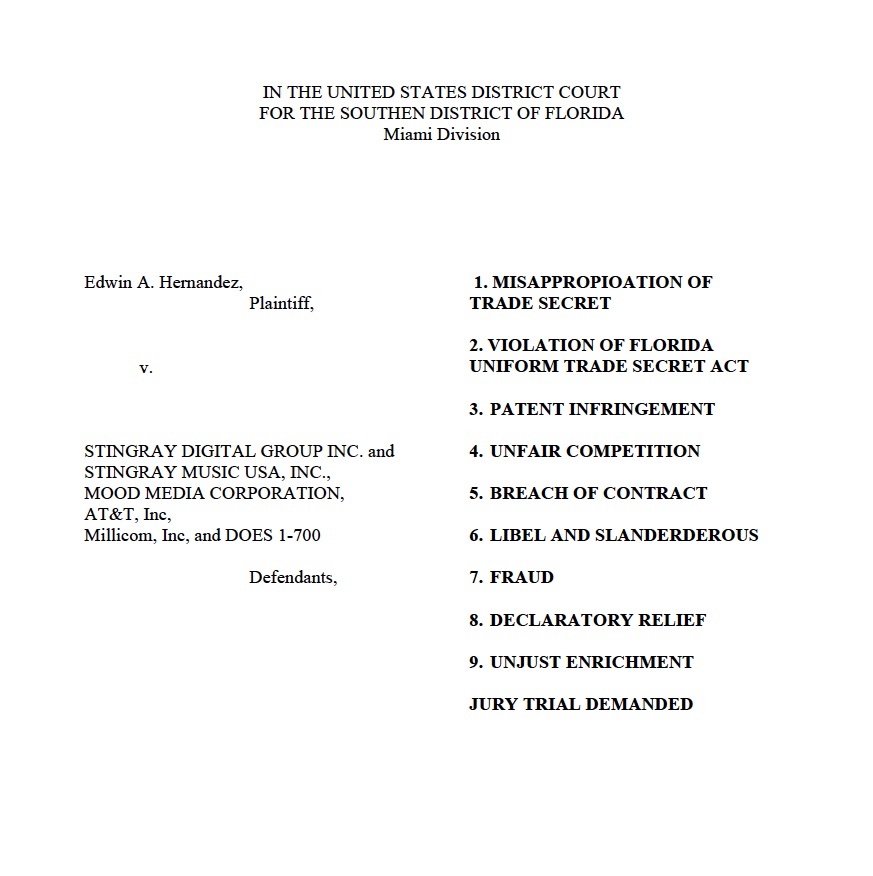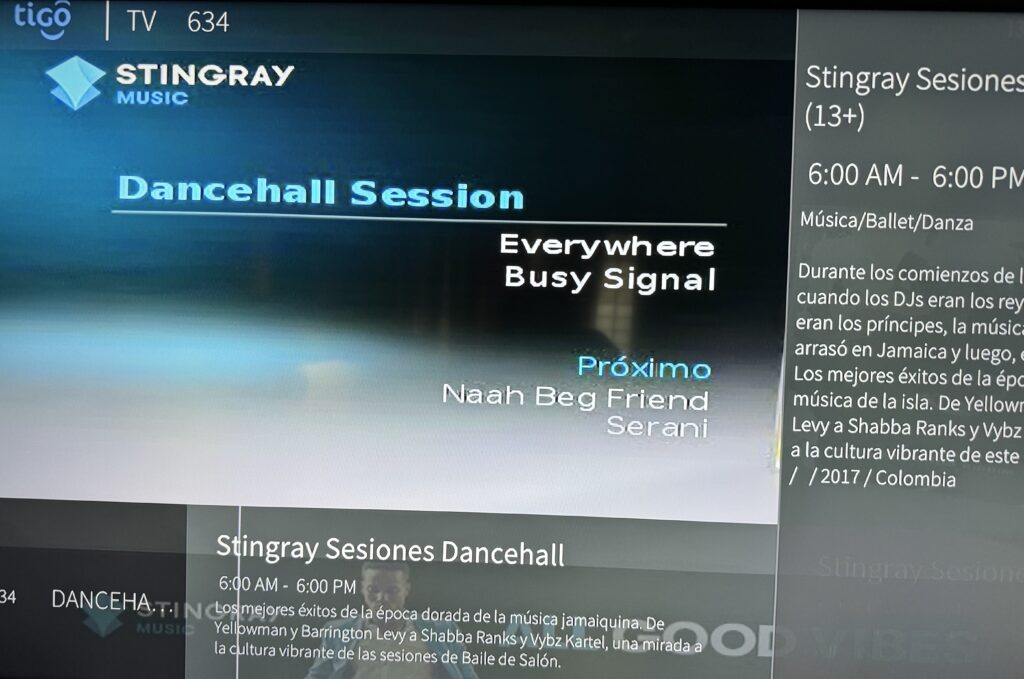Stingray Lawsuit: Dr. Hernandez v. Stingray Digital Group, Stingray Music USA, Inc, MOOD MEDIA, AT&T, MILLICOM, Inc, and Does1-700
Dr. Hernandez is the inventor for a patent porfolio and technologies in the media streaming world. Those being US Patent Nos. 10,123,074 (“the ‘074 patent”); 10,524,002 (“the ‘002 patent”), 11,140,441 (“the ‘441 patent”); and allowed US Patent Application 17/4930490 (“the ‘490 allowed patent application”) with a total of 94 issued claim. His European Patent EP3238457 with 8 claims available in 17 jurisdictions: including: AT – Austria, BE – Belgium, DE – Germany, DK – Denmark, EE – Estonia, ES – Spain, FI – Finland, FR – France, GB – United Kingdom, HU – Hungary, IS – Iceland, IT – Italy, NL – Netherlands, NO – Norway, PL – Poland. PT – Portugal, and SE – Sweden.
As of April 2nd, 2024, while Dr. Hernandez was testifying at trial in front of Judge Kane and the jury for the civil litigation “Blue Radios, Inc vs. KOPIN,” this litigation started. Dr. Hernandez expertise was put to use at Denver’s US District Court in a matter involving trade secret misappropriation, patent disputed in ownership, among other issues.
Therefore, Dr. Hernandez knows and understands what is the threshold required for litigation and survival of motions for summary judgement, etc.
In all fairness, Dr. Hernandez made numerous attempts to make Stingray a customer and get things right, but all his offers and feedback were ignored. Instead, Stingray sent a letter from their counsel, AZA law, which responded insinuating that Dr. Edwin gained illegal access to Stingray’s “proprietary information,” which is shown is totally false, as the information used for a demand letter to Stingray was available at a public website and anyone could access it.
Dr,. Edwin was left with no option but to file this legal action and around April 2nd, against defendants: Stingray Digital Group, Stingray Music USA, MOOD MEDIA, AT&T and MILLICOM, Inc, and others that are customers to Stingray Digital. Under the lawsuit at Case 1:24-cv-21226-RAR
In the complaint, Dr. Hernandez, describes the history behind the complaint and how he used, now publicly available records, to sustain his allegations. Among other evidence, the Exhibits 10, 11, and 15. include Stingray’s public documents that map his trade secrets to the accused software. Additionally, Dr. Hernandez goes thru the events that took place in 2014 during the MOOD MEDIA sale of DMX for $16M to Stingray Digital Group.
Exhibits 10 and 11 were not discovered by Dr. Hernandez until mid April-2021 when Dr. Hernandez found a website and those are PDF files from what it was found online. By April 20th, 2021, Dr. Hernandez concludes misappropriation took place and sent a “Cease and Desist” letter to Stingray Digital.
As part of the evidence. Dr. Hernandez can demonstrate trade secret misappropriation by Stingray Digital Group, Inc and how MOOD MEDIA was instrumental to get a contract signed with Dr. Edwin’s company, EGLA that facilitated Dr. Hernandez’ unlawful disclosure of trade secrets to Stingray. MOOD MEDIA finalized a $16M transaction dated March 2014, but Dr. Hernandez was deprived from such gains, future gains, and puts in jeopardy his entire portfolio.
The events unfolded until 2021, as Stingray Digital is still very secretive about all of their technologies, and the accused platform. It was not until around April 20th, 2021 that Dr. Hernandez was able to finalize the examination of the contents of Exhibits 10 and 11, that he extracted from a publicly available trello.com account. All these evidence and information, that was publicly available, was removed from the internet, after the litigation was filed, in a process called ” Spoliation of evidence.”
As a consequence of the trade secret misappropriation, Stingray and all its customers now infringe the entire portfolio of 4 issued US patents and 1 European patent, where Dr. Hernandez is the sole inventor and owner.. Dr. Hernandez reserve the rights to file more matters in other jurisdictions.
The complaint and allegations (lawsuit) are incorporated herein:
Dr. Hernandez Technology and Brief History.
In and around 2012 – 2013, Dr. Hernandez began consulting for DMX Media that later was acquired by MOOD MEDIA for $86M. As part of these efforts, Dr. Hernandez created a cloud-based platform for music streaming, filled with APIs, metadata, and was in service for many customers DMX/MOOD MEDIA had at the time.
Around 2013, MOOD MEDIA sells DMX to Stingray Digital, by that time Dr. Hernandez had expanded his cloud-based platform to a series of servers that he called “EGLA MEDIAPLUG” that via software updates will change how content is delivered to cable operators.
The servers contained source code that was being used by Dr. Hernandez to test multiple other functions and technologies that were required for better Cable/Satellite integration. As these endeavors began, Dr. Hernandez showed music-only services fully operational, while was sharing, under NDA, the details of his HTML-based system that integrated all web assets into the distribution of music with Cable TV operators.
Dr. Hernandez was unaware and MOOD never notified him that by December 2013, they were selling DMX to Stingray Digital, and all his servers were switching hands to new people. These new individuals, were the same executives that MOOD had working with Dr. Hernandez. Hence, Dr. Hernandez was unable to conclude that all his trade secrets and intellectual property was being exposed to 3rd parties.
In 2014, as DMX customers were transferred to Stingray Digital, Dr. Hernandez’ was forced to keep his platform operational and was not allowed to delete, under contract, any of the files that were contained in his servers, as the same servers were used for delivery of music-only content.
As the transaction was completed, executives from MOOD, Stingray Digital, including VP of Legal and General Managers guaranteed to Dr. Hernandez that “no IP was transferred” and “Dr. Hernandez’ IP was not needed,”, everybody parted ways and Dr. Hernandez didn’t pursue any legal action as there was no proof of any wrongdoing.
UbiquiCAST is one of the most obscured platforms, but during the Music Choices v. Stingray Digital Group patent lawsuit, some information was exposed, but not enough to formulate an opinion. Dr. Hernandez even offered Stingray Digital his portfolio as a defense agains Music Choice. Stingray appeared to not care and paid over $13M in settlement and $9M in legal fees instead.
By 2021, while Dr. Hernandez was searching online and trying to see if there was anything else out there that could determine who Stingray preferred to pay $21M to Music Choice. Dr. Hernandez rans into 600+ publicly available trouble tickets from a public website called troll.co.
Upon Digging into the detail logs and others, Dr. Hernandez is able to draft a claim chart and concludes that Stingray Digital stole his IP while the MOOD MEDIA transaction was taking place, and notifires Stingray Digital of all his findings in this letter.
Response, accusing Dr. Hernandez of accessing “Proprietary” information unlawfully, and other responses from Stingray thru their counsel AZA Law.
EVIDENCE ATTACHED TO THE COMPLAINT – EXHIBITS
Dr. Hernandez accuses Stingray of stealing his trade secrets to develop a new software version for the UbiquiCAST Server, that during the Music Choice’s litigation was called OSE2. Dr. Hernandez, by conducting routine online searching, ran into a website that contained over 600+ trouble tickets filed by engineers working for Stingray Digital Group in and around 2014 until around 2018-19,. The technical trouble tickets showed Stingray’s logs and technical details of their software. In fact, one of the tickets shows the “migration” from “DMX” (aka Dr. Hernandez’ platform).
The PDF files for Exhibits 10 and 11 are shown herein (This information was deleted by Trello,com around April 5th, 2024, right after this action as filed):.
For example, “DMX” integration is the 1st page of Exhibit 11.
It was also valuable for Dr. Hernandez to review the case with Music Choice and Stingray Digital Group, where the judge cites a few items from the “redacted” portions of the filings, and gives some clues and names that in the vacuum are not clear. However, once the details on Exhibits 10 and 11 are known, the citations by this prior litigation matter, start making sense and the connections to its trade secrets and patents can now be derived. .
What is Stingray Music?
The Stingray lawsuit covers “Stingray Music”. Stingray Music is a streaming product distributed using a device called UbiquiCAST, which has two versions OSE1 (On-Screen Enhancements 1) and OSE2 (On-Screen Enhancements 2). The UbiquiCAST product is then distributed across the planet to cable TV operators that include AT&T U-verse®, TIGO by Million, Inc, Cablevision Mexico, and over 700+ cable providers around the world.
Since 2014, Stingray Digital Group, Inc:
- File an IPO for C$140M raise,
- Went from ~C$30M in Revenues to over C$300M
- Reached 400M subscribers in 700+ Cable Operators.
- Acquired radio stations in Canada, purchased many companies in M&A deals
The filing was done in the Southern District of Florida, Miami Division under:
1i24-cv-21226-RAR Hernandez v. Stingray Digital Group Inc. et al
Rodolfo A. Ruiz, II, presiding
Date filed: 04/02/2024
Date of last filing: 04/03/2024


